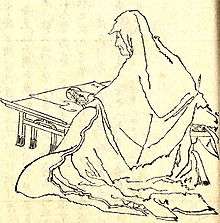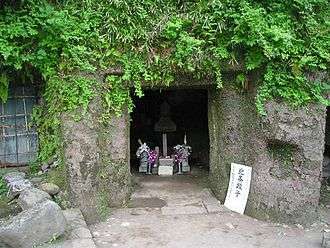Hōjō Masako
Hōjō Masako (北条 政子, 1156 – August 16, 1225) was a political leader, and the eldest daughter of Hōjō Tokimasa (the first shikken, or regent, of the Kamakura shogunate) by his wife Hōjō no Maki. She was the sister of Hōjō Yoshitoki, and was married to Minamoto no Yoritomo, the first shōgun of the Kamakura period. She was also the mother of O-Hime, Minamoto no Yoriie and Minamoto no Sanetomo, the second and third shōguns. She is thought by scholars to have exercised significant power in the early years of the Kamakura period, which was reflected by her contemporary sobriquet of the "nun shogun".[1]
Hōjō Masako | |
|---|---|
 Hōjō Masako by Kikuchi Yōsai (菊池 容斎) | |
| Midaidokoro | |
| Personal details | |
| Born | 1157 |
| Died | 16 August 1225 (aged 69) |
| Spouse(s) | Minamoto no Yoritomo |
| Relations | Hōjō Yoshitoki (brother) Kujō Yoritsune (grandson-in-law) |
| Children | Minamoto no Yoriie Minamoto no Sanetomo |
| Parents | Hōjō Tokimasa |
Early life to marriage (1156–1182)
Hōjō Masako was born in 1156, eldest child of Hōjō Tokimasa, leader of the influential Hōjō clan of Izu province, and his wife, Hōjō no Maki. Masako's parents were still in their teens, she was raised by many ladies-in-waiting and nannies. Masako was born into a world of war and strife. In Kyoto, the capital of Japan, the Hōgen Rebellion was in full swing. Cloistered Emperor Toba and Emperor Sutoku warred over who would be the next emperor. The Hōjō clan wisely chose to stay out of the rebellion, even though the Hōjō family was descended from the Taira clan and thus was related to the imperial family.
During the Heiji Rebellion in 1159, the Taira clan under Taira no Kiyomori, defeated the Minamoto clan with the support of Cloistered Emperor Go-Shirakawa. Minamoto no Yoshitomo, leader of the Minamoto clan, was executed while his sons and daughters were either executed or sent to nunneries. Of his surviving sons, Minamoto no Yoshitsune and Minamoto no Noriyori were forced into priesthood, while Minamoto no Yoritomo, at the age of thirteen, was exiled to Izu in the domain of Hōjō Tokimasa. While this was happening, Masako was barely an infant. The Taira under Kiyomori now were in successful control of Japan.
Masako was the oldest child of fifteen.[1] She was instructed in horseback riding, hunting, fishing, and she ate with men rather than with the women of the household. Her brother, Hōjō Yoshitoki, was born in 1163 would eventually become a member of the Rokuhara Tandai. Another of her brothers, Hōjō Tokifusa, would become the second Hōjō shikken (regent) of the Kamakura shogunate and head of the Hōjō clan.
Masako married Yoritomo around 1177,[2][3] against her father's wishes[1]. In 1182, they had their first daughter, Ō-Hime. As Yoritomo's wife, she participated in the government administration and eventually became a representation of power for men of the Hōjō clan.[4]
The same year a disillusioned Imperial Prince Mochihito, son of Emperor Go-Shirakawa, called on the Minamoto members remaining in Japan to overthrow the Taira. Mochihito thought the Taira had denied him the throne to offer the throne to Emperor Antoku, who was half Taira. Minamoto no Yoshitomo considered himself the head of the Minamoto and responded. He had the full support of the Hōjō and Hōjō Tokimasa, not to mention Masako. The Minamoto center was at the city of Kamakura, to the east of Izu in Sagami Province.
Thus, the Genpei War, the final war between Minamoto and Taira had begun. In 1180, Masako's elder brother Munetoki was killed at Battle of Ishibashiyama and Yoshitoki became heir of Hōjō clan. In 1181, Taira no Kiyomori died, leaving the Taira in the hands of his son Taira no Munemori. In 1182, Masako and Yoritomo had their first son, Minamoto no Yoriie, who would be the heir.
The Genpei War and its aftermath (1182–1199)
In 1183, Yoritomo's rival and cousin Minamoto no Yoshinaka took Kyoto, forcing the Taira (and Emperor Antoku) to Shikoku. Quickly, Emperor Go-Toba was installed by the Minamoto. Nonetheless, Minamoto no Yoshitsune and Minamoto no Noriyori, Yoritomo's half brothers who had joined Yoritomo drove Yoshinaka out and executed him, and took Kyoto in the name of Yoritomo (and the Hōjō.)
By 1185, the Taira were completely defeated at the Battle of Dan-no-ura. Munemori was executed, while the remaining Taira either were executed or drowned, including the young Emperor Antoku. Minamoto no Yoritomo was now the undisputed leader of Japan. Hōjō Masako and her family had stood by Yoritomo through it all. She rode with him on his campaigns and was never defeated in battle.[5]
His new allegiance to his wife's family and her dislike of her brothers-in-law, as well as an internal power struggle brought up by the three brothers, eventually resulted in the arrest and execution of Yoshitsune and Noriyori. Yoritomo even created new titles, such as shugo and jitō, which Hōjō Tokimasa received approval from Cloistered Emperor Go-Shirakawa in Kyoto. The capital was not moved to Kyoto, but remained away from the court in Kamakura.
In 1192, Yoritomo was named shōgun by Cloistered Emperor Go-Shirakawa, who died later that year. He was now the most powerful man in Japan, and gave that power over to Masako and the Hōjō clan. That same year Masako and Yoritomo had another son, Minamoto no Sanetomo.
Death, corruption, and familial strife (1199–1205)
In 1199, Minamoto no Yoritomo died. He was succeeded as shōgun by his son, Minamoto no Yoriie. Since he was only eighteen, Hōjō Tokimasa proclaimed himself shikken or regent for Yoriie. Masako also had a strong position since her son was shōgun. Since her husband was dead, she shaved her head and became a Buddhist nun, receiving a tonsure from the priest Gyōyū. However, she did not take up residence in a monastery or a nunnery, and still involved herself in politics. Along with her father Tokimasa and her brother Yoshitoki, Masako created a council of regents for the eighteen-year-old Yoriie. The headstrong shōgun hated his mother's family and preferred his wife's family, the Hiki clan, and his father-in-law, Hiki Yoshikazu.
Hōjō Masako overheard a plot that Yoshikazu and Yoriie were hatching, and turned in her own son to Tokimasa, who did not hurt Yoriie but had Yoshikazu executed in 1203. Now, Shōgun Yoriie was very sick and retired to Izu Province. He was murdered in 1204, no doubt by Tokimasa's orders. Masako had not been aware of this. During the murders and purges of the Hiki clan, Minamoto no Ichiman, Yoriie's eldest son and heir and Masako's grandson, was also executed since he was part Hiki himself.
In 1203, Masako's other son by Yoritomo, Minamoto no Sanetomo, became the third shōgun with Tokimasa as regent. Sanetomo was closer to his mother than his elder brother was, and still a child when appointed shōgun, by contrast his brother, who was forced to abdicate as shōgun was now an adult. Nonetheless, Masako and Yoshitoki, the heir to the Hōjō, were angry with their father, especially after their mother, Hōjō no Maki, died in 1204. Masako's sister's husband, Hatekayama Shigetada, was wrongfully executed on Tokimasa's orders even after Yoshitoki, Masako, and Tokifusa told Tokimasa he was not guilty of the "treason" charges. Hōjō Tokimasa was by 1205 the most powerful man in Kamakura.
Masako heard rumors that Tokimasa was planning to execute Sanetomo and replace him with one of his allies, so Masako and Yoshitoki immediately ordered Tokimasa to step down and go into priesthood or they would rebel. Hōjō Tokimasa abdicated in 1205, and was sent off to a monastery in Kamakura, where he shaved his head and became a monk, dying in 1215.
The later years (1205–1225)

While Tokimasa had been ousted in 1205 and Minamoto no Sanetomo was shōgun, the position of the Hōjō clan was still secure. Masako's brother, Hōjō Yoshitoki, succeeded as shikken for Sanetomo, while Masako was in a powerful position as a negotiator with the court. In 1218, Masako was awarded the Junior Second Rank (Ritsuryō (律令)) by the imperial government, and continued to work towards the creation of an advisory council.[4] During this time, she was sent by Regent Yoshitoki to ask Cloistered Emperor Go-Toba if Minamoto no Sanetomo could adopt one of his sons as an heir, such as Imperial Prince Nagahito, but Go-Toba refused.
Shōgun Minamoto no Sanetomo was executed in 1219 by the son of Minamoto no Yoriie, which ended the Minamoto line. Masako and Hōjō Yoshitoki selected Kujō Yoritsune, known as Fujiwara no Yoritsune, as the next shōgun. Since Yoristune was still an infant at this time, Masako acted as de facto shōgun and his overseer until her death[4]. Despite Kujō Yoritsune being a member of the Kujō clan, which was part of the Fujiwara clan, Yoritsune's grandmother was the niece of first shōgun Yoritomo. While not a member of the Hōjō, or a male-line Minamoto, he was still a figurehead for the Hōjō clan.
During the Jōkyū War of 1221, Go-Toba rebelled against the Hōjō with the goal of restoring power to the emperor. Regent Yoshitoki and his eldest son, Hōjō Yasutoki, attacked Kyoto and managed to regain the city resulting in the exile Go-Toba. Masako continued to consolidate rule under the advisory council, manage the relationships and connections between imperial and aristocratic families, and administer judgments and postwar rewards[4]. She represents an era that acknowledged the authority and legitimacy of women in rule, and Masako is recognized as a source of power that enabled the Hōjō clan to dominate the Kamakura Shogunate until the downfall of the government in 1333.[4]
Hōjō Masako died in 1225 at the age of 69. Due to her true example of cloistered rule, she was known as the ama-shōgun, or the "nun-shōgun". The official government chronicle, Eastern Mirror, represented her as the equivalent of Empress Lü in China and Empress Jingū of Japan[4].
In Fiction
- Kusa Moeru 1979 Taiga drama, Shima Iwashita played Hōjō Masako.
See also
| Wikimedia Commons has media related to Hōjō Masako. |
References
- Japan emerging : premodern history to 1850. Friday, Karl F. Boulder, Colorado. 2012-03-06. ISBN 978-0-8133-4561-1. OCLC 787849954.CS1 maint: others (link)
- Sato, Hiroaki (1995). Legends of the Samurai. Overlook Duckworth. pp. 147–148. ISBN 9781590207307.
- Sansom, George (1958). A History of Japan to 1334. Stanford University Press. p. 371. ISBN 0804705232.
- Smith, Bonnie G. (2008). Hōjō Masako (1157–1225). Oxford University Press. ISBN 9780195148909.
- Jones 1997, pp. 37–38
Sources
- Jones, David E. (1997). Women Warriors: a History. Garden City, New York: Brassey's. ISBN 9781574881066.